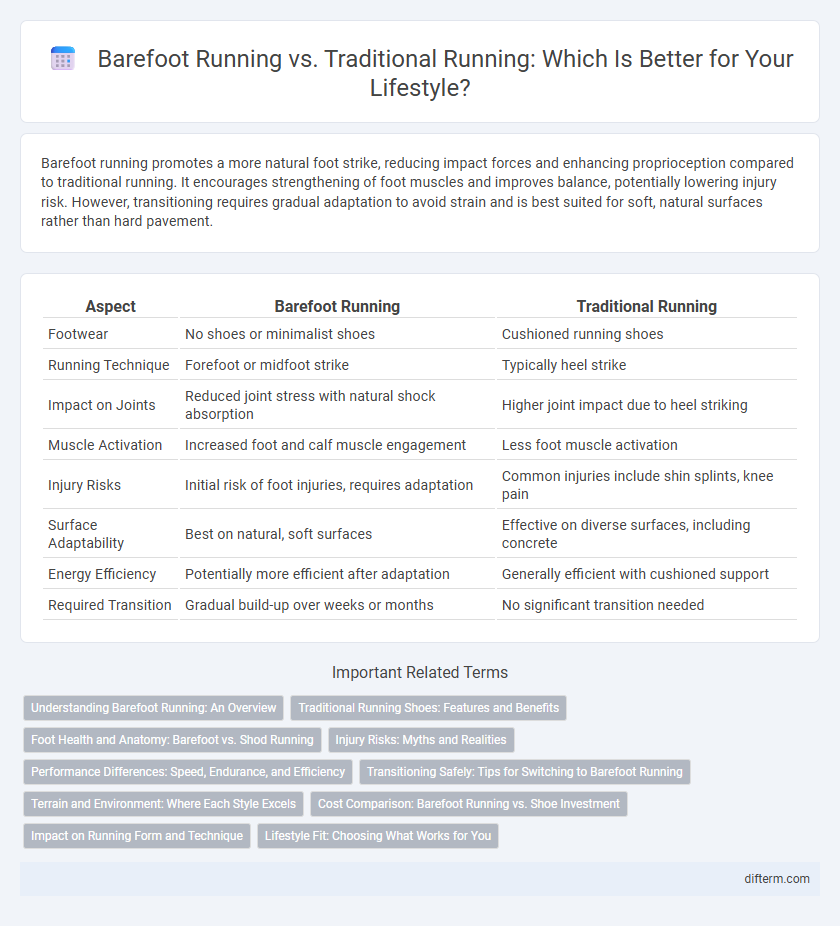Barefoot running promotes a more natural foot strike, reducing impact forces and enhancing proprioception compared to traditional running. It encourages strengthening of foot muscles and improves balance, potentially lowering injury risk. However, transitioning requires gradual adaptation to avoid strain and is best suited for soft, natural surfaces rather than hard pavement.
Table of Comparison
| Aspect | Barefoot Running | Traditional Running |
|---|---|---|
| Footwear | No shoes or minimalist shoes | Cushioned running shoes |
| Running Technique | Forefoot or midfoot strike | Typically heel strike |
| Impact on Joints | Reduced joint stress with natural shock absorption | Higher joint impact due to heel striking |
| Muscle Activation | Increased foot and calf muscle engagement | Less foot muscle activation |
| Injury Risks | Initial risk of foot injuries, requires adaptation | Common injuries include shin splints, knee pain |
| Surface Adaptability | Best on natural, soft surfaces | Effective on diverse surfaces, including concrete |
| Energy Efficiency | Potentially more efficient after adaptation | Generally efficient with cushioned support |
| Required Transition | Gradual build-up over weeks or months | No significant transition needed |
Understanding Barefoot Running: An Overview
Barefoot running emphasizes natural foot movement and promotes stronger foot muscles by eliminating the cushioning and support of traditional running shoes. This style encourages a forefoot or midfoot strike, which can reduce impact forces and lower the risk of certain injuries compared to heel striking common in traditional running. Adapting to barefoot running requires gradual transition and attention to proper form to prevent strain or injury.
Traditional Running Shoes: Features and Benefits
Traditional running shoes feature cushioned midsoles, structured arch support, and durable outsoles designed to absorb impact and protect joints during intense running sessions. Engineered with breathable mesh uppers and advanced technologies like motion control and stability enhancements, these shoes provide reliable comfort and injury prevention for long-distance runners. Their design promotes proper foot alignment and reduces strain, making them ideal for athletes seeking consistent performance and support.
Foot Health and Anatomy: Barefoot vs. Shod Running
Barefoot running promotes natural foot mechanics by encouraging a forefoot or midfoot strike, which reduces impact stress on joints and strengthens intrinsic foot muscles. Traditional shod running often leads to heel striking, which can increase the risk of repetitive stress injuries due to cushioning that alters natural gait patterns. Research shows that barefoot running enhances proprioception and foot arch development, contributing to overall foot health and injury prevention.
Injury Risks: Myths and Realities
Barefoot running reduces the impact on joints by promoting a forefoot strike, which can lower the risk of certain injuries compared to traditional heel striking. However, transitioning too quickly to barefoot running increases the likelihood of foot and calf strains due to insufficient adaptation. Studies show that both barefoot and traditional running carry injury risks based on running form, surface, and volume rather than shoe type alone.
Performance Differences: Speed, Endurance, and Efficiency
Barefoot running often enhances proprioception and foot muscle strength, contributing to improved running economy and efficiency compared to traditional running with cushioned shoes. Studies show barefoot runners may achieve faster stride turnover and reduced ground contact time, positively impacting speed and endurance during moderate distances. However, transition phases require adaptation to avoid injury, as barefoot running places different biomechanical stresses on the feet and lower legs.
Transitioning Safely: Tips for Switching to Barefoot Running
Transitioning to barefoot running requires gradual adaptation to avoid injuries, emphasizing a slow increase in mileage and incorporating foot-strengthening exercises. Choosing safe, soft surfaces like grass or trails minimizes impact stress while allowing natural foot mechanics to develop. Proper attention to form, such as shorter strides and midfoot striking, supports a smooth and safe transition from traditional running.
Terrain and Environment: Where Each Style Excels
Barefoot running excels on natural, softer terrains such as grass, dirt trails, and sand, where the foot's natural cushioning and proprioception minimize impact and enhance sensory feedback. Traditional running shoes provide greater protection and support on hard, urban surfaces like concrete and asphalt, reducing the risk of injuries from repetitive impact and uneven pavement. Each style adapts uniquely to environmental demands, with barefoot running promoting natural foot mechanics and traditional running optimizing stability and comfort in varied terrains.
Cost Comparison: Barefoot Running vs. Shoe Investment
Barefoot running eliminates the need for purchasing expensive running shoes, significantly reducing costs associated with traditional running footwear, which can range from $80 to $150 per pair. Over time, the investment in high-performance running shoes adds up, whereas barefoot runners may only need minimal accessories like foot protection or specialized socks, costing under $30. This cost difference makes barefoot running an economical choice for runners seeking to minimize their overall expenses without compromising training frequency.
Impact on Running Form and Technique
Barefoot running promotes a forefoot or midfoot strike, encouraging a natural stride that reduces impact forces on the joints. Traditional running shoes often lead to heel striking, which can increase the risk of injury due to higher impact stress. Adapting technique for barefoot running requires strengthening foot muscles and improving proprioception for better balance and efficient movement.
Lifestyle Fit: Choosing What Works for You
Barefoot running encourages a more natural gait and can enhance foot strength and balance, appealing to those seeking a minimalist, holistic lifestyle. Traditional running shoes provide cushioning and support, reducing impact and catering to runners prioritizing injury prevention and comfort. Choosing the right approach depends on personal biomechanics, comfort preferences, and lifestyle goals for sustainable fitness.
barefoot running vs traditional running Infographic

 difterm.com
difterm.com